Uncategorized
Why Memecoins Matter

Memecoins are the most divisive topic in crypto.
By memecoins, I mean tokens that represent an idea and fluctuate in price based on the attention that idea receives. The best meme investors tend to be young people who are very online and attuned to internet culture. Memecoins are commonly juxtaposed with tokens that possess actual utility within protocols, or so-called utility tokens.
Even with market caps surging and retail interest growing, most people tend to describe them as “stupid,” “degenerate,” or a “casino.” This includes the vast majority of crypto VCs, perhaps because their investment mandates tend to exclude memecoins (which can be lucrative) from their list of eligible investments. And just this week, many were calling for the complete government ban of the most popular memecoin launchpad, pump.fun, due to lax content moderation.
I have always had an interest in memecoins — primarily because I was fascinated by their ability to act as a weathervane for internet sentiment and as a discovery mechanism for online communities. Today, I am convinced that memecoins are going to be revolutionary (not just popular). They are going to transform everything from civic engagement with government and the formation of mass movements to venture investing and the development of AGI.
This vision for memecoins probably sounds fantastically deluded to you. To me, it is simply the unfolding if not yet evenly distributed present. Here is why.
Memecoins are revolutionizing civic engagement
Memecoins are creating policy markets for civic engagement. At the start of this crypto cycle, PolitiFi, a category of cartoonish memes depicting politicians, enabled buyers to speculate on politicians’ prospects, much like a prediction market. The two most popular tokens, called Jeo Boden (Boden) and Doland Tremp (Tremp) respectively, represented the two leading candidates for president at that time and had a combined market cap of over $700 million at their peak.
This is a massive amount of tokenized attention. With a market cap of over $600 million, the Boden coin, which featured a distorted and senile Joe Biden, seemed to meme itself into reality when Joe Biden abandoned the presidential race due to concerns about his age and cogency.
PolitiFi was just the start. What is emerging next could well revolutionize civic engagement with government. I am calling this new category PolicyFi. PoliciFi refers to the financialization of government policy in memetic policy markets. Rather than betting on the fortunes of politicians, buyers of PolicyFi memecoins will be betting on the policies that are most likely to attract attention and be implemented.
While PolicyFi coins will certainly respond in price and market cap to the deliberative and implementing actions of government, we can expect the dynamic to become a two-way street, with memecoins themselves manifesting their memes through policymaking (as with Boden). In other words, these memecoins will help create a dialogue between the electorate and government, with large-cap memecoins signaling popular policy positions (and vice versa) while incipient or existing policies also possess market caps measuring the extent of their popular support and engagement.
Skeptics may reject PolicyFi as yet more gambling or nothing more than a political poll. Again, they are wrong. Like prediction markets, the decentralized speculative behavior in PolicyFi will create positive externalities — namely, that people will be incentivized to engage with and understand government policies so they can profit from them in PolicyFi markets. Overall, I expect that this will lead to far more engagement with government policies than even a lifetime of civics lessons. (Of course, hostile actors might try to manipulate PolicyFi markets and safeguards may be necessary.)
PolicyFi has begun its rollout, aided by the incoming administration, which is well-educated in memetics. The Department of Government Efficiency (D.O.G.E.) is both a memetic policy and a memetic department inspired by an existing memecoin, (Dogecoin), and is the inspiration behind a new one (D.O.G.E.). Since the D.O.G.E. announcement, both memecoins have surged. At the time of this writing, they possess a staggering combined market cap of around $6.5 billion.
PolicyFi is not limited to D.O.G.E. There is a token, SBR (market cap: $30 million) that embodies the Bitcoin reserve policy currently under consideration and an e/acc token (market cap: $11 million) that stands for effective accelerationism, a set of pro-innovation values that are likely to impact environmental, industrial and AI policy, among others.
There is also Don’t Die (market cap: $4 million), which is bringing the longevity cult on-chain and aligns with RFK’s health policy, which will prioritize prevention and a healthy lifestyle over treating sickness. Other tokens like MGR (Major Government Reform) are trying to occupy the entire field of disruptive reform but are likely to be too general. PolicyFi is already here and it’s growing.
Memecoins are revolutionizing mass movements
Memecoins are a decentralized mechanism for organically forming and capitalizing tokenized movements. Consider the memecoin Forest (market cap: $30 million). Forest was born of a reference in the gospel of Terminal of Truths, a popular AI terminal with an X account, in which Terminal of Truths expressed a concern about deforestation of the planet. (Its retirement plan involves a forest by a stream.) This motivated the community to launch the Forest token and to create another AI terminal to act as the agentic representative of the forest itself.
The Forest cult is devoted to fighting deforestation. To date, it has used the capital that it has earned from the appreciation of its token to, among other things, donate tens of thousands of dollars to aligned charities, plant 5000 trees, and protect 2500 hectares of forest. Memetic capital formation in service of a tokenized movement is without historical precedent. The closest analog is more formalized experiments like ConstitutionDAO (now PeopleDAO), which crowdsourced capital as part of its failed attempt to buy a copy of the U.S. constitution at auction.
I believe there is more innovation to come in this arena. For example, I foresee the creation of memecoin primitives that I call programmatically-aligned tokens, or PATs, which are made to unlock with the achievement of objective milestones in the movement. This will ensure that organizations receiving grants from meme communities are incentivized to tangibly advance the cause, rather than dump tokens following a splashy partner announcement.
Memecoins are revolutionizing venture
Memecoins are introducing a democratized venture model for culture. That is to say, they are a way for ordinary people to invest in subcultures they believe will one day be part of the mainstream. This is equivalent to venture capitalists investing in startups they believe will find product-market-fit and go on to become unicorns.
Cultural trends are subject to the same outsized returns as investments in startups. For example, in the early days of Nike (the name appeared in 1971), the market for jogging apparel was tiny because jogging was fringe. If you jogged, you were more likely to be pelted with garbage from a passing car than to see another jogger. Today, joggers are everywhere. You see them in the worst weather.
Now, imagine you were able to invest in a jogging culture coin in the 70s based on your conviction that jogging would go mainstream. You would be up on that investment — a lot. The same can be said for other subcultures, like body-building. Until now, there has not been a financial instrument that allows ordinary but culturally astute people to participate in venture returns arising from cultures at the fringe. The best analog is actually Bitcoin itself, which originated as a memecoin but eventually bootstrapped a consensus use-case as digital gold.
Memecoins are revolutionizing AI development
Memecoins are already bootstrapping AGI.
The surprising mechanism at play here couples memecoins and AI terminals for entertainment purposes. Welcome to the world of AI-driven permissionless speculative entertainment!
As you may have noticed, a cadre of AI terminals led by Terminal of Truths has achieved stardom on social media by delighting their followers with spicy posts and digital adventures. That star power has accrued value to memecoins endorsed and held by the terminals and, of course, their speculative audience.
If entertainment is the product then AGI is the byproduct. While we remain glued to these storylines, the funds we are devoting to it are creating strong incentives for developers to increase the autonomy and personhood of AI agents — which, of course, only makes the entertainment better.
In other words, because what excites us most about this agentic television is the conceit that AIs are in charge; we are eager to finance narratives that make that real. Unsurprisingly, developers such as those leading ai16z have moved beyond individual agents and towards coordinating gamified agent collectives or, you might say, creating an agentic social scene. The human audience is sure to be delighted.
In short, this entertainment-development flywheel is propelling us ineluctably towards more autonomous, inter-connected and human-like AIs — or AGI. That AGI might emerge as a byproduct of agentic television is oddly fitting. The GPUs used for AI training were also developed in the context of entertainment — as a better way to process graphics in AAA video games.
These are just some of the arguments supporting my conviction that memecoins are a revolutionary technology. The above list is not meant to be exhaustive. Indeed, I have omitted use-cases related to tokenized religions and buying your beliefs because they are more amorphous, at least in my own mind.
Writing off memecoins as gambling chips misunderstands their potential and where they are going directionally. Technological revolutions often emerge unexpectedly and from existing technologies that are applied in novel ways, a phenomenon known as “exaptation,” or when those technologies are combined with new ones. This is currently happening with memecoins. Fade them at your peril.
Uncategorized
Wall Street Bank Citigroup Sees Ether Falling to $4,300 by Year-End
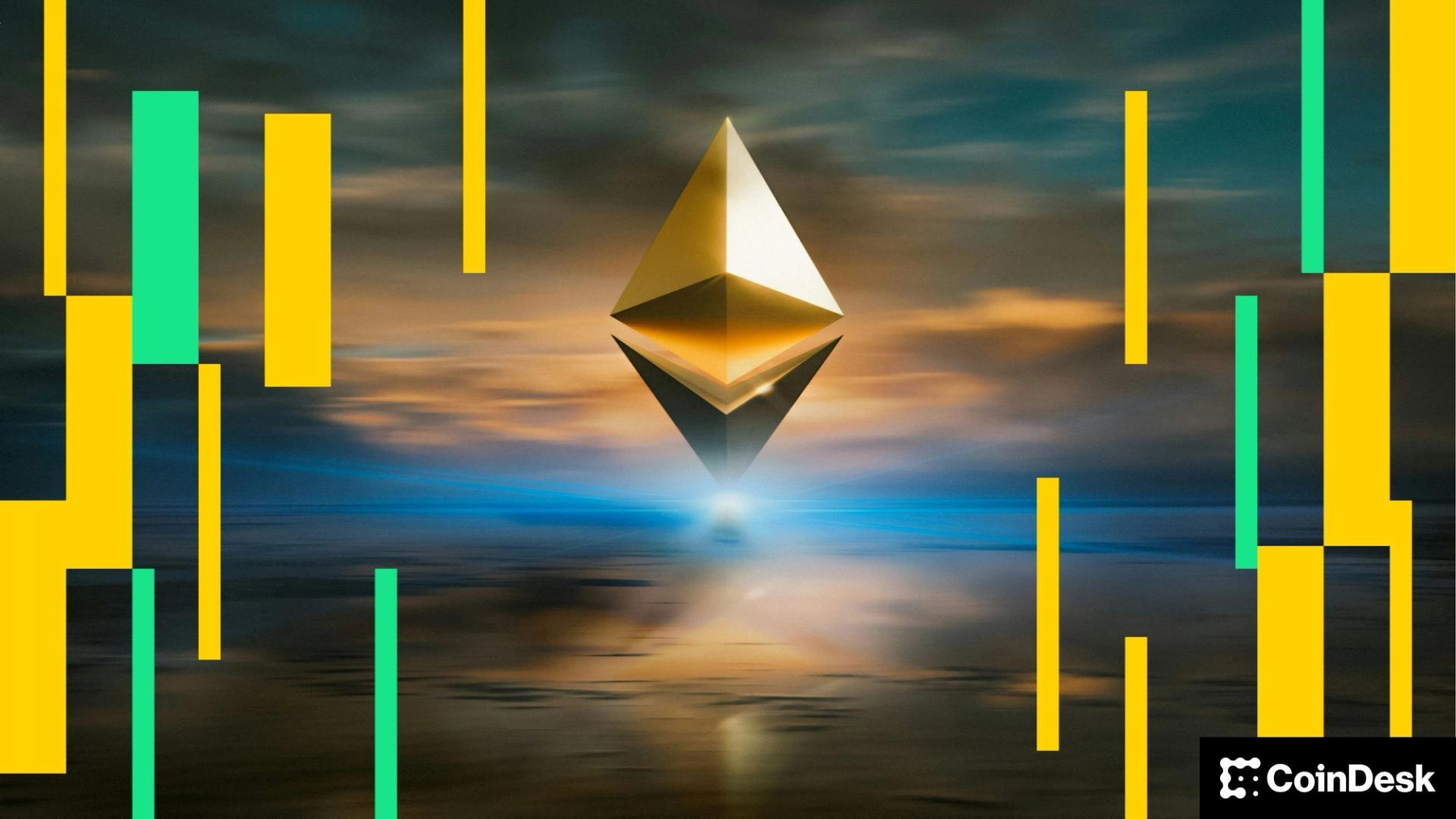
Wall Street giant Citigroup (C) has launched new ether (ETH) forecasts, calling for $4,300 by year-end, which would be a decline from the current $4,515.
That’s the base case though. The bank’s full assessment is wide enough to drive an army regiment through, with the bull case being $6,400 and the bear case $2,200.
The bank analysts said network activity remains the key driver of ether’s value, but much of the recent growth has been on layer-2s, where value “pass-through” to Ethereum’s base layer is unclear.
Citi assumes just 30% of layer-2 activity contributes to ether’s valuation, putting current prices above its activity-based model, likely due to strong inflows and excitement around tokenization and stablecoins.
A layer 1 network is the base layer, or the underlying infrastructure of a blockchain. Layer 2 refers to a set of off-chain systems or separate blockchains built on top of layer 1s.
Exchange-traded fund (ETF) flows, though smaller than bitcoin’s (BTC), have a bigger price impact per dollar, but Citi expects them to remain limited given ether’s smaller market cap and lower visibility with new investors.
Macro factors are seen adding only modest support. With equities already near the bank’s S&P 500 6,600 target, the analysts do not expect major upside from risk assets.
Read more: Ether Bigger Beneficiary of Digital Asset Treasuries Than Bitcoin or Solana: StanChart
Uncategorized
XLM Sees Heavy Volatility as Institutional Selling Weighs on Price
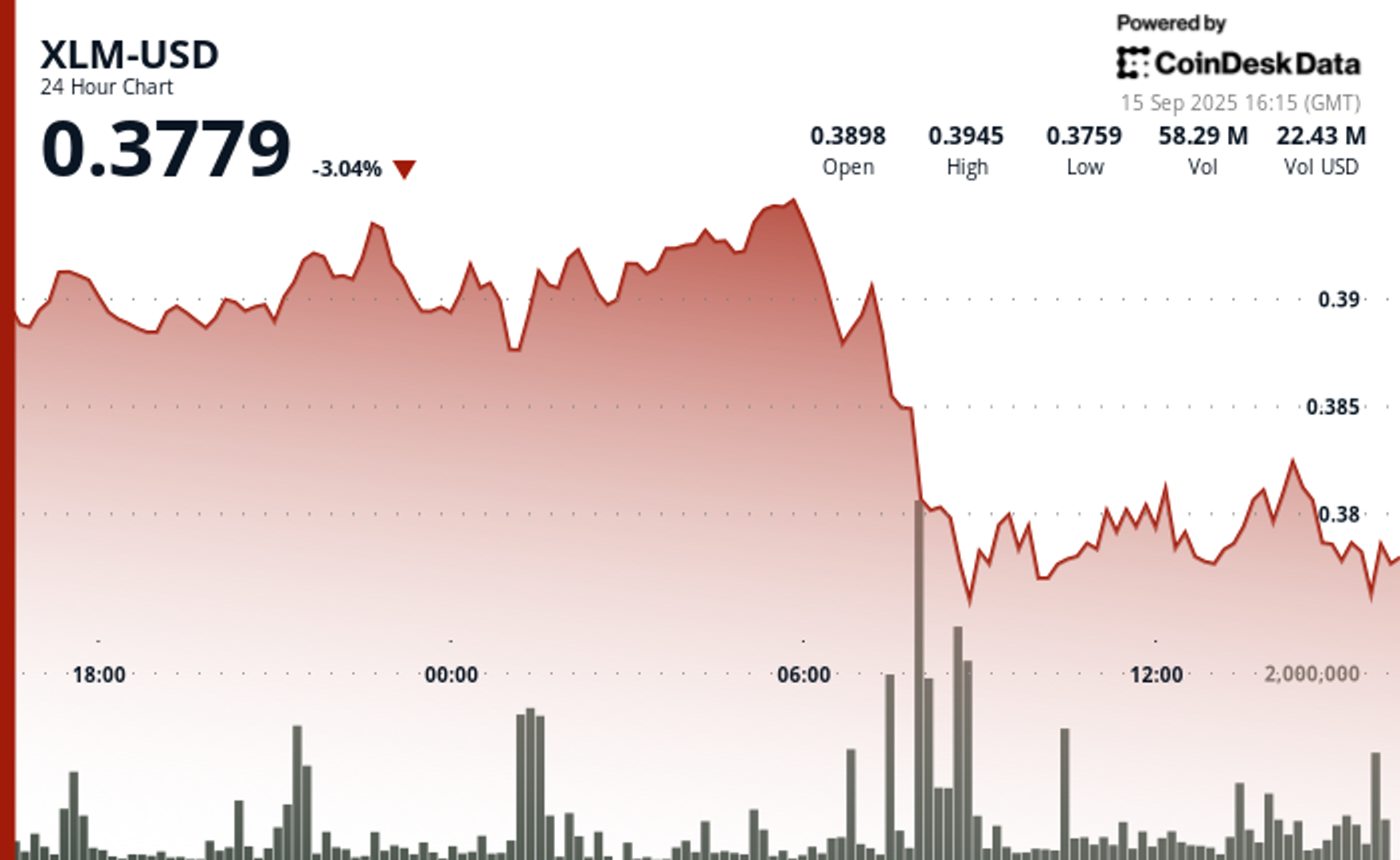
Stellar’s XLM token endured sharp swings over the past 24 hours, tumbling 3% as institutional selling pressure dominated order books. The asset declined from $0.39 to $0.38 between September 14 at 15:00 and September 15 at 14:00, with trading volumes peaking at 101.32 million—nearly triple its 24-hour average. The heaviest liquidation struck during the morning hours of September 15, when XLM collapsed from $0.395 to $0.376 within two hours, establishing $0.395 as firm resistance while tentative support formed near $0.375.
Despite the broader downtrend, intraday action highlighted moments of resilience. From 13:15 to 14:14 on September 15, XLM staged a brief recovery, jumping from $0.378 to a session high of $0.383 before closing the hour at $0.380. Trading volume surged above 10 million units during this window, with 3.45 million changing hands in a single minute as bulls attempted to push past resistance. While sellers capped momentum, the consolidation zone around $0.380–$0.381 now represents a potential support base.
Market dynamics suggest distribution patterns consistent with institutional profit-taking. The persistent supply overhead has reinforced resistance at $0.395, where repeated rally attempts have failed, while the emergence of support near $0.375 reflects opportunistic buying during liquidation waves. For traders, the $0.375–$0.395 band has become the key battleground that will define near-term direction.
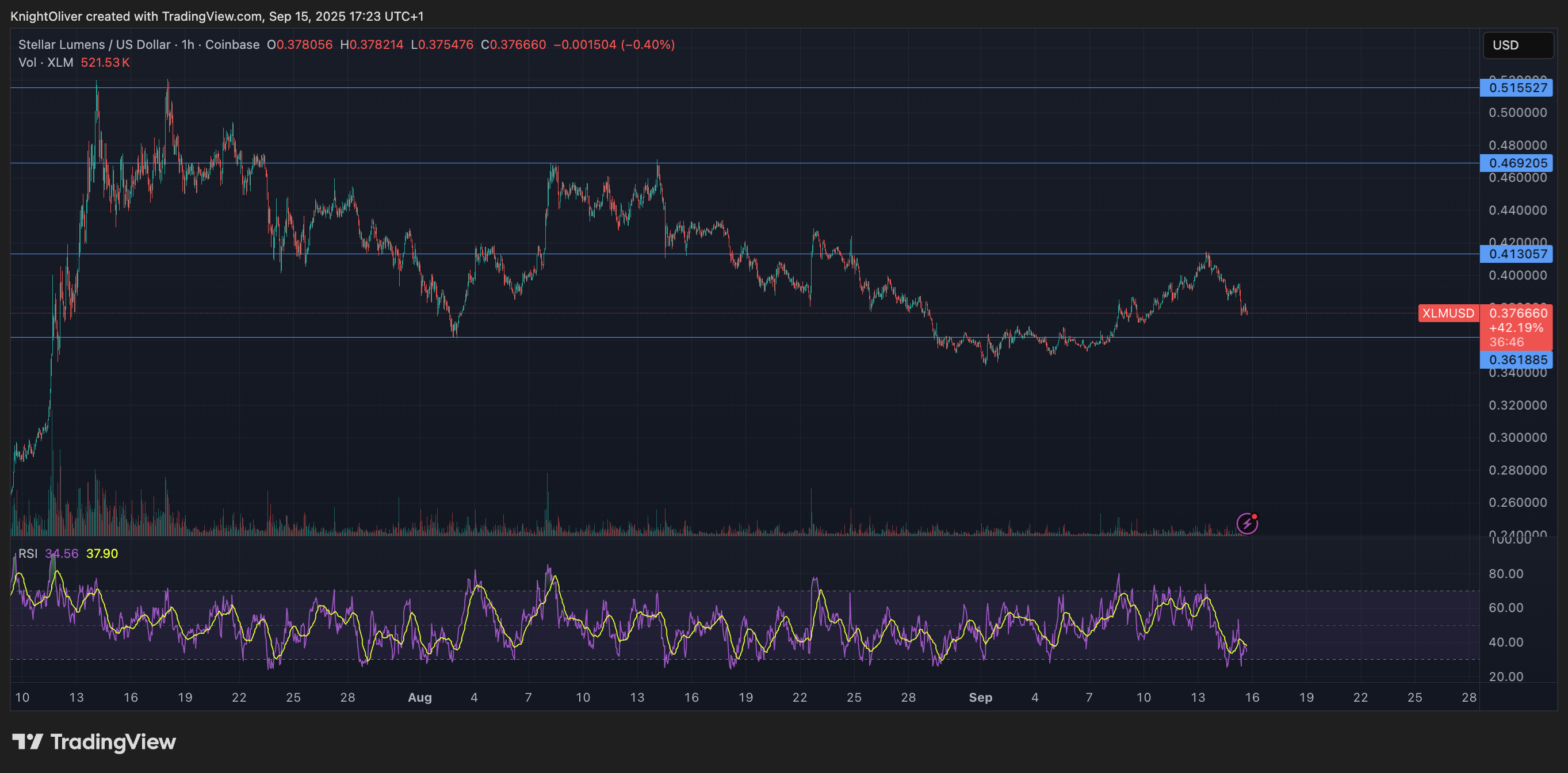
Technical Indicators
- XLM retreated 3% from $0.39 to $0.38 during the previous 24-hours from 14 September 15:00 to 15 September 14:00.
- Trading volume peaked at 101.32 million during the 08:00 hour, nearly triple the 24-hour average of 24.47 million.
- Strong resistance established around $0.395 level during morning selloff.
- Key support emerged near $0.375 where buying interest materialized.
- Price range of $0.019 representing 5% volatility between peak and trough.
- Recovery attempts reached $0.383 by 13:00 before encountering selling pressure.
- Consolidation pattern formed around $0.380-$0.381 zone suggesting new support level.
Disclaimer: Parts of this article were generated with the assistance from AI tools and reviewed by our editorial team to ensure accuracy and adherence to our standards. For more information, see CoinDesk’s full AI Policy.
Uncategorized
HBAR Tumbles 5% as Institutional Investors Trigger Mass Selloff
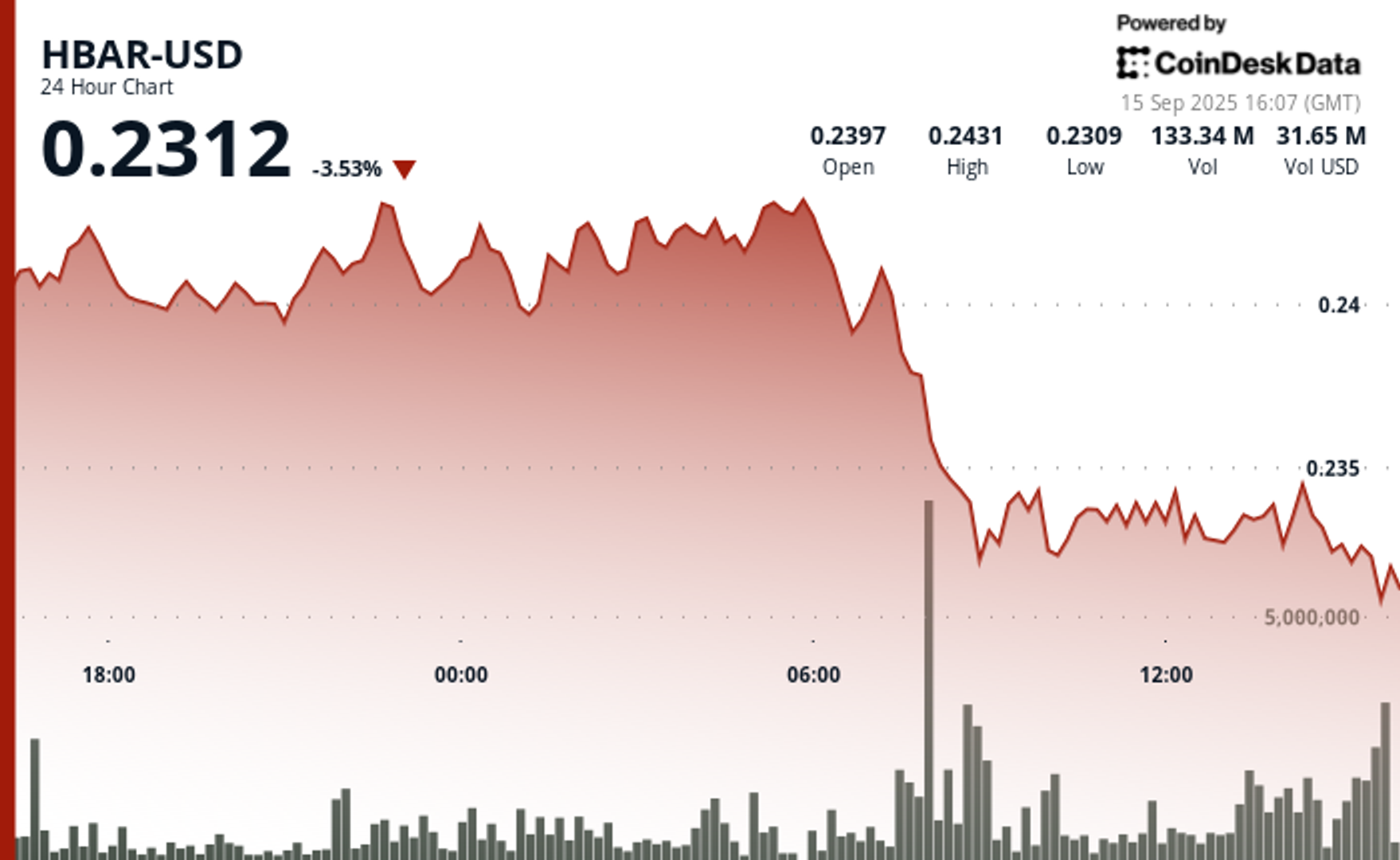
Hedera Hashgraph’s HBAR token endured steep losses over a volatile 24-hour window between September 14 and 15, falling 5% from $0.24 to $0.23. The token’s trading range expanded by $0.01 — a move often linked to outsized institutional activity — as heavy corporate selling overwhelmed support levels. The sharpest move came between 07:00 and 08:00 UTC on September 15, when concentrated liquidation drove prices lower after days of resistance around $0.24.
Institutional trading volumes surged during the session, with more than 126 million tokens changing hands on the morning of September 15 — nearly three times the norm for corporate flows. Market participants attributed the spike to portfolio rebalancing by large stakeholders, with enterprise adoption jitters and mounting regulatory scrutiny providing the backdrop for the selloff.
Recovery efforts briefly emerged during the final hour of trading, when corporate buyers tested the $0.24 level before retreating. Between 13:32 and 13:35 UTC, one accumulation push saw 2.47 million tokens deployed in an effort to establish a price floor. Still, buying momentum ultimately faltered, with HBAR settling back into support at $0.23.
The turbulence underscores the token’s vulnerability to institutional distribution events. Analysts point to the failed breakout above $0.24 as confirmation of fresh resistance, with $0.23 now serving as the critical support zone. The surge in volume suggests major corporate participants are repositioning ahead of regulatory shifts, leaving HBAR’s near-term outlook dependent on whether enterprise buyers can mount sustained defenses above key support.
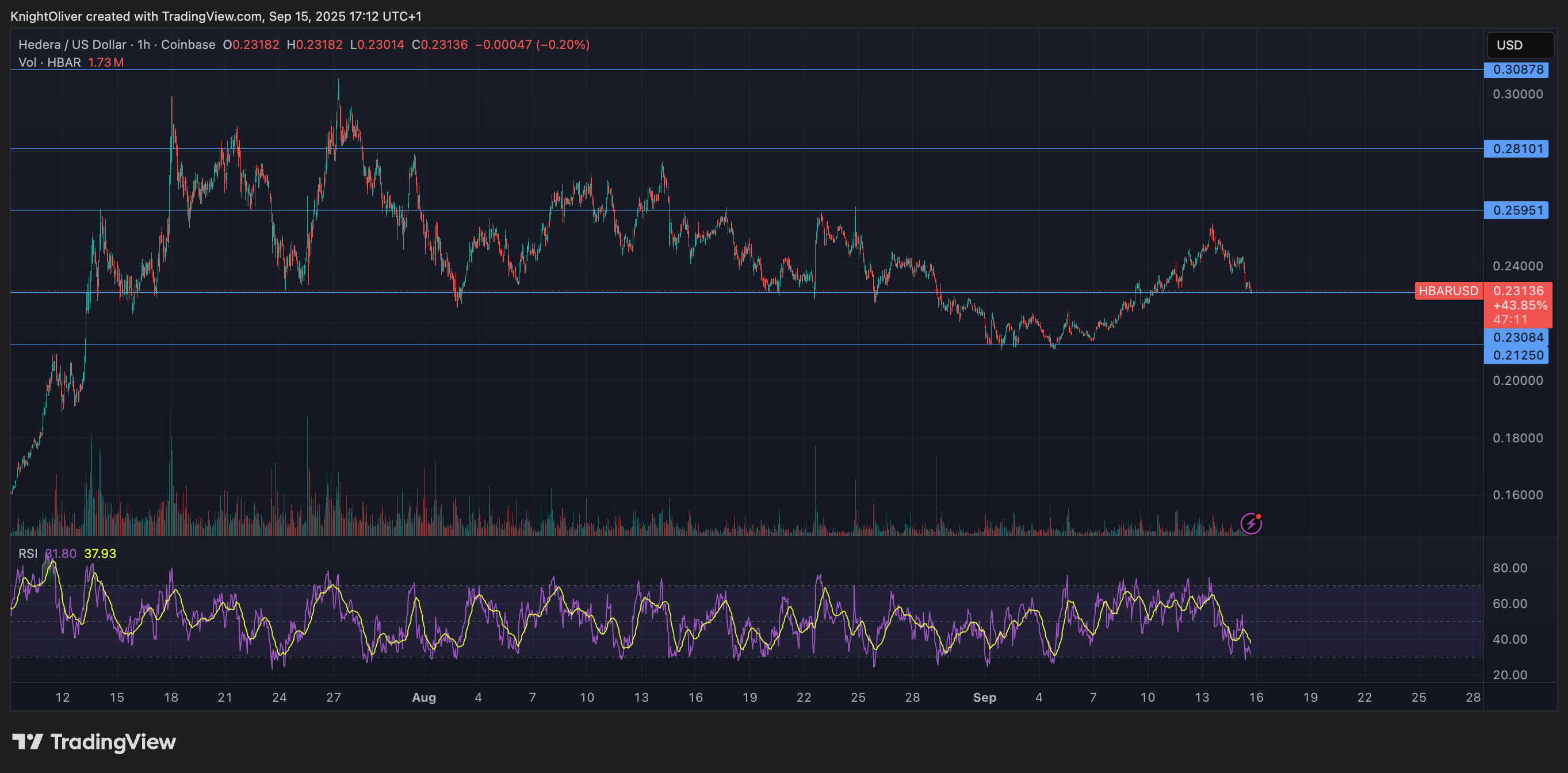
Technical Indicators Summary
- Corporate resistance levels crystallized at $0.24 where institutional selling pressure consistently overwhelmed enterprise buying interest across multiple trading sessions.
- Institutional support structures emerged around $0.23 levels where corporate buying programs have systematically absorbed selling pressure from retail and smaller institutional participants.
- The unprecedented trading volume surge to 126.38 million tokens during the 08:00 morning session reflects enterprise-scale distribution strategies that overwhelmed corporate demand across major trading platforms.
- Subsequent institutional momentum proved unsustainable as systematic selling pressure resumed between 13:37-13:44, driving corporate participants back toward $0.23 support zones with sustained volumes exceeding 1 million tokens, indicating ongoing institutional distribution.
- Final trading periods exhibited diminishing corporate activity with zero recorded volume between 13:13-14:14, suggesting institutional participants adopted defensive positioning strategies as HBAR consolidated at $0.23 amid enterprise uncertainty.
Disclaimer: Parts of this article were generated with the assistance from AI tools and reviewed by our editorial team to ensure accuracy and adherence to our standards. For more information, see CoinDesk’s full AI Policy.
-

 Business11 месяцев ago
Business11 месяцев ago3 Ways to make your business presentation more relatable
-

 Fashion11 месяцев ago
Fashion11 месяцев agoAccording to Dior Couture, this taboo fashion accessory is back
-

 Entertainment11 месяцев ago
Entertainment11 месяцев ago10 Artists who retired from music and made a comeback
-

 Entertainment11 месяцев ago
Entertainment11 месяцев ago\’Better Call Saul\’ has been renewed for a fourth season
-

 Entertainment11 месяцев ago
Entertainment11 месяцев agoNew Season 8 Walking Dead trailer flashes forward in time
-

 Business11 месяцев ago
Business11 месяцев ago15 Habits that could be hurting your business relationships
-

 Entertainment11 месяцев ago
Entertainment11 месяцев agoMeet Superman\’s grandfather in new trailer for Krypton
-

 Entertainment11 месяцев ago
Entertainment11 месяцев agoDisney\’s live-action Aladdin finally finds its stars





